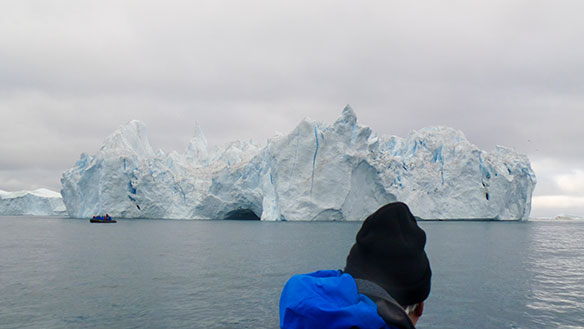
Adventure Canada’s Ilulissat tours offer (n)ice viewings

IAN STALKER
(Photo above: Adventure Canada uses Zodiacs on its excursions among icebergs near Ilulissat, Greenland.)
Adventure Canada clients who scoop up some ice on Zodiac tours off the coast of Ilulissat, Greenland, to place in upcoming drinks in their ship’s lounge can expect that that ice predates the alcohol they’re enjoying.
In fact, it probably well predates that alcohol, says environmental geoscientist Charlotte Mougeot, who lectures on Adventure Canada’s High Arctic sailing from Resolute Bay, Nunavut
to the west coast of Greenland.
“If you want to pick up some very old ice [that’s bobbing in the water] the likelihood is that that ice is 20,000 to 30,000 years old,” she says.
The Ilulissat area is home to the Jakobshavn Isbræ Glacier, which Adventure Canada labels “the fastest-calving glacier in the world (and which) spills thousands of enormous icebergs” into ocean waters every year.
The glacial ice works its way into the Arctic ocean waters, with some of that ice being small enough to scoop up by hand, while other ice forms can be massive.
Ilulissat, which translates as icebergs and was the birthplace of famed polar explorer Knud Rasmussen, is also seen as a prime spot to see the effect global warming is having on the Arctic.
Ilulissat-area icebergs – one of which, some speculate, was responsible for sinking the Titanic – can look large to those in the Zodiacs. Most of a ‘berg is submerged and, therefore, invisible to people above the waterline.
Guide Jim Narraway notes the Zodiacs have to keep a careful distance from icebergs, with “impact waves” a possibility if a large chunk of ice breaks free and crashes into the water.
Travelling among the imposing icebergs is dramatic, says Mougeot, who’s worked in different Arctic regions.
“This is my favourite Zodiac ride in the world,” she says of the Ilulissat excursions.
